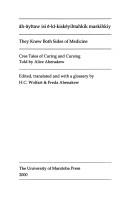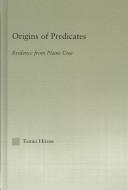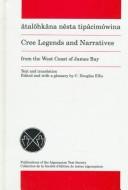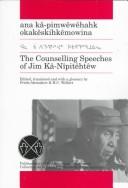| Listing 1 - 7 of 7 |
Sort by
|

ISBN: 1283090619 9786613090614 0887553109 9780887553103 0887556493 9780887556494 0887564933 9780887564932 9781283090612 6613090611 Year: 2000 Publisher: Winnipeg, Man. University of Manitoba Press
Abstract | Keywords | Export | Availability | Bookmark
 Loading...
Loading...Choose an application
- Reference Manager
- EndNote
- RefWorks (Direct export to RefWorks)
Born in 1912, Alice Ahenakew was brought up in a traditional Cree community in north-central Saskatchewan. As a young woman, she married Andrew Ahenakew, a member of the prominent Saskatchewan family, who later became an Anglican clergyman and a prominent healer. Alice Ahenakew's personal reminiscences include stories of her childhood, courtship and marriage, as well as an account of the 1928 influenza epidemic and encounters with a windigo. The centrepiece of this book is the fascinating account of Andrew Ahenakewís bear vision, through which he received healing powers. Written in original Cree text with a full English translation, They Knew both Sides of Medicine also includes an introduction discussing the historical background of the narrative and its style and rhetorical structure, as well as a complete Cree-English glossary.
Cree language --- Cree Indians --- Algonquian Indians --- Indians of North America --- Clistenos language --- Cris language --- Iyiniwok language --- Kalisteno language --- Kenistenoag language --- Killisteno language --- Knistenaux language --- Knisteneux language --- Maskegon dialect --- Plains Cree language --- Woods Cree language --- Algonquian languages --- Atikamekw language --- Medicine. --- English.

ISBN: 1138994693 1135885524 1280052007 020350903X 9780203509036 9786610052004 661005200X 0415967791 9780415967792 9781135885526 9781135885472 1135885478 9781135885519 1135885516 9781138994690 0415967791 9780415967792 0203605454 9781280052002 Year: 2003 Publisher: New York Routledge
Abstract | Keywords | Export | Availability | Bookmark
 Loading...
Loading...Choose an application
- Reference Manager
- EndNote
- RefWorks (Direct export to RefWorks)
This book offers a new perspective on natural language predicates by analyzing data from the Plains Cree language. Contrary to traditional understanding, Cree verbal complexes are syntactic constructs composed of morphemes as syntactic objects that are subject to structurally defined constraints, such as c-command. Tomio Hirose illustrates this in his study of vP syntax, event semantics, morphology-syntax mappings, unaccusativity, noun incorporation, and valency-reducing phenomena.
Cree language --- Clistenos language --- Cris language --- Iyiniwok language --- Kalisteno language --- Kenistenoag language --- Killisteno language --- Knistenaux language --- Knisteneux language --- Maskegon dialect --- Plains Cree language --- Woods Cree language --- Algonquian languages --- Atikamekw language --- Verb. --- Syntax. --- Morphology. --- Grammar --- North and Central American indian languages
Book
ISBN: 0889774307 9780889774308 9780889774292 0889774293 Year: 2016 Publisher: Regina, Saskatchewan
Abstract | Keywords | Export | Availability | Bookmark
 Loading...
Loading...Choose an application
- Reference Manager
- EndNote
- RefWorks (Direct export to RefWorks)
"As an Elder once said, "Learn one Cree word a day for 100 days, and emerge a different person." In 100 Days of Cree Neal McLeod offers a portal into another way of understanding the universe--and our place within it--while demonstrating why this funny, vibrant, and sometimes salacious language is "the sexiest" of them all (according to Tomson Highway). Based on a series of Facebook posts, the 100 short chapters or "days" in the book present chains of related words, some dealing with the traditional--the buffalo hunt, the seasons--and others cheekily capturing the detritus of modern life--from internet slang to Johnny Cash songs to Viagra."--
Cree language --- Clistenos language --- Cris language --- Iyiniwok language --- Kalisteno language --- Kenistenoag language --- Killisteno language --- Knistenaux language --- Knisteneux language --- Maskegon dialect --- Plains Cree language --- Woods Cree language --- Algonquian languages --- Atikamekw language --- Vocabulary. --- Aboriginal. --- Indigenous. --- contemporary. --- introduction to Cree. --- language.

ISBN: 0887551599 9780887551598 9780887553165 0887553168 1283090678 9786613090676 Year: 1995 Publisher: Winnipeg, Man. University of Manitoba Press
Abstract | Keywords | Export | Availability | Bookmark
 Loading...
Loading...Choose an application
- Reference Manager
- EndNote
- RefWorks (Direct export to RefWorks)
This is the first major body of annotated texts in James Bay Cree, and a unique documentation of Swampy and Moose Cree (Western James Bay) usage of the 1950s and 1960s. Conversations and interviews with 16 different speakers include: legends, reminiscences, historical narratives, stories and conversations, as well as descriptions of technology. The book includes a detailed pronunciation guide, notes on Cree terms, informants' comments, dialect variations, and descriptions of cultural values and customs. The introduction describes and compares the various genres in traditional and popular culture. Cree and English, with full glosssary.
Cree Indians --- Cree language --- Legends --- Social life and customs. --- Clistenos language --- Cris language --- Iyiniwok language --- Kalisteno language --- Kenistenoag language --- Killisteno language --- Knistenaux language --- Knisteneux language --- Maskegon dialect --- Plains Cree language --- Woods Cree language --- Algonquian languages --- Atikamekw language --- Folk tales --- Traditions --- Urban legends --- Folklore

ISBN: 1283091186 9786613091185 0887553710 9780887553714 0887556485 9780887556487 Year: 1998 Publisher: Winnipeg University of Manitoba Press
Abstract | Keywords | Export | Availability | Bookmark
 Loading...
Loading...Choose an application
- Reference Manager
- EndNote
- RefWorks (Direct export to RefWorks)
Jim Ka-Nipitehtew was a respected Cree Elder from Onion Lake, Saskatchewan, who spoke only Cree and provided these original counselling discourses. The book offers the speeches in Cree syllabics and in Roman Orthography as well as an English translation and commentary. The Elder offers guidance for First Nations people in these eight speeches that cover the proper performance of ceremonies, words of encouragement for youth, information about collecting medicinal plants, directions for proper behaviour of men toward women, proper preparations for the Pipe ceremony, the role of the Pipestem in the Making of Treaty 6, the importance of tobacco, and examples of improper ritual behaviour in ceremonies. One of the most important speeches is the narrative of the Cree record for the treaty negotiations that took place in the summer of 1876. It was originally transmitted by Jim Ka-Nipitehtew's father directly to him and the authors comment on this remarkable chain of transmission. The book contains a Cree-English and an English-Cree Glossary. This is an important resource for Cree linguistics as well as those interested in understanding the Cree perspective of Treaty 6.
Cree language --- Cree Indians --- Cri (Langue) --- Cris (Indiens) --- Clistenos language --- Cris language --- Iyiniwok language --- Kalisteno language --- Kenistenoag language --- Killisteno language --- Knistenaux language --- Knisteneux language --- Maskegon dialect --- Plains Cree language --- Woods Cree language --- Algonquian languages --- Atikamekw language --- Algonquian Indians --- Indians of North America --- English. --- Religion. --- History. --- Histoire.
Book
ISBN: 0889774366 9780889774360 9780889774353 Year: 2016 Publisher: Regina, Saskatchewan Canada
Abstract | Keywords | Export | Availability | Bookmark
 Loading...
Loading...Choose an application
- Reference Manager
- EndNote
- RefWorks (Direct export to RefWorks)
"Tânisi! With the help of this book, you can learn to speak Cree! Designed as an introduction for Cree language learners, mâci-nêhiyawêwin: Beginning Cree acts as a self-study aid--a much-needed resource in today's world where few can speak Cree fluently. Basic grammar units and everyday vocabulary items guide the student through the building blocks of the language, and expansion drills and exercises reinforce lessons and prepare the student for further study. With over 100 illustrations, this text grounds the language in traditional and contemporary contexts"--
Cree language --- Clistenos language --- Cris language --- Iyiniwok language --- Kalisteno language --- Kenistenoag language --- Killisteno language --- Knistenaux language --- Knisteneux language --- Maskegon dialect --- Plains Cree language --- Woods Cree language --- Algonquian languages --- Atikamekw language --- English. --- FOREIGN LANGUAGE STUDY --- Native American Languages. --- Aboriginal tongues. --- Cree textbook. --- Indigenous language.
Book
ISBN: 9780889773479 0889773475 0889773459 Year: 2014 Publisher: Regina University of Regina
Abstract | Keywords | Export | Availability | Bookmark
 Loading...
Loading...Choose an application
- Reference Manager
- EndNote
- RefWorks (Direct export to RefWorks)
"So often, it is through humour that the big lessons in life are learned--about adult responsibilities, honour, and respect. Cree people love to make jokes and laugh, so the tales in Woods Cree Stories are filled with wit. The book includes nine stories--including Boys Get Lost, Foolishness, and Animals Become Friends--and a Woods Cree-English glossary. All the stories are presented in Cree syllabics, Standard Roman Orthography, and English translation"--
Cree language --- Cree Indians --- Algonquian Indians --- Indians of North America --- Clistenos language --- Cris language --- Iyiniwok language --- Kalisteno language --- Kenistenoag language --- Killisteno language --- Knistenaux language --- Knisteneux language --- Maskegon dialect --- Plains Cree language --- Woods Cree language --- Algonquian languages --- Atikamekw language --- Aboriginal language, Woods Cree, Indigenous.
| Listing 1 - 7 of 7 |
Sort by
|

 Search
Search Feedback
Feedback About UniCat
About UniCat  Help
Help News
News